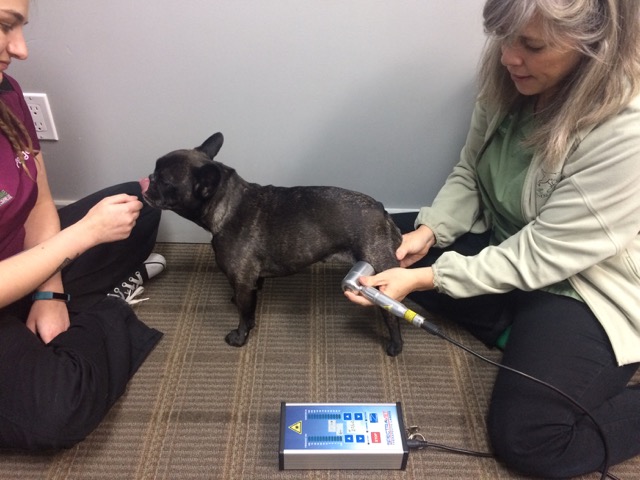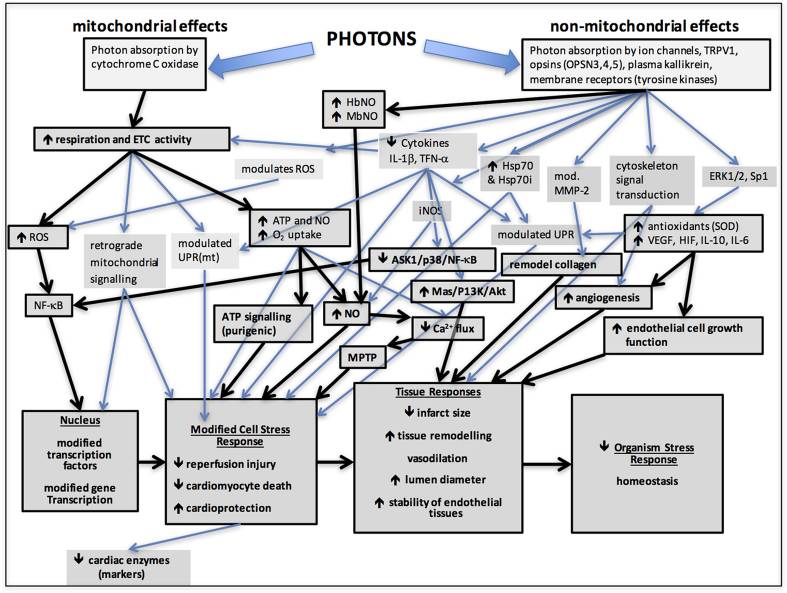| print
link to this post | email a friend Our Magic Wand – Laser Therapy11 Jan 2019
Chances are, if you have visited The Canine Fitness Centre Ltd, your dog has received laser therapy. It’s one of our favourite tools because it’s the perfect additive to most all of our treatment plans! So, it seems only appropriate to give you a little extra information on this nifty piece of equipment.
We’ve been using laser therapy at the clinic since the mid 2000’s. We’ve learned the science. We’ve seen the results. We routinely update ourselves on the research. And we teach it to the vets and physiotherapists that intern with us. In other words, it’s not ‘new’ to us. It’s a trusted friend!
Laser therapy has been around since the mid 60’s (in research). However, it only really became therapeutically available in the 90’s in ‘human’ physiotherapy clinics, and it took off like wildfire in the animal rehabilitation field in the late 2000’s. Why? Well, as I mentioned before, it’s a very versatile tool that can be used to treat so many things.
Firstly, the science behind laser therapy involves many biological processes. Check out the picture below! Holy crumb! That’s all of the stuff the laser does. Put on your geeky scientist cap as you peruse that diagram!!
But if it all looks like gobbledygook, then I’ll simplify it for everyone involved. It stimulates the mitochondria in each cell which improves cell health and functioning. It stimulates tissue growth (great for muscles, tendon, joint cartilage, bone, nerves, blood vessels, etc.)! It improves blood flow. It reduces nerve firing (which can be helpful in reducing pain), and can also have an anti-inflammatory effect. Additionally, it has antimicrobial effects, so it’s nice for treating wounds because it will help with healing and reduce bacteria in the wound. Double win!
The other fabulous thing is that laser is very safe. Over the years, research is showing that we can use higher and higher doses! Other than wound healing (where we use low doses), it is virtually impossible to overdose with laser, and adverse reactions are exceedingly rare!
What don’t we laser? Well, one doesn’t typically laser the eye (although new protocols are being developed). Some of the high-powered lasers require the wearing of goggles incase the laser beam bounces into the eye, which may cause damage. However, with the lower powered lasers (like the ones we use at The Canine Fitness Centre Ltd), there isn’t a need for goggles because the laser probe is placed direction on the skin and held stationary. The lower powered lasers are the ones primarily studied in research too, which is why we only have them at the clinic. We don’t laser over a pregnant uterus – not that it’s been tested, but just because it’s unknown if it could hurt a fetus. Laser is also contraindicated over an area that is actively bleeding. There is conflicting evidence in regards to using laser in cases of cancer. It is okay to use in area away from the cancer site, and there are differences in the literature in regards to using it directly over a tumour. (In petri-dish science experiments, laser stimulats cancer cells, however in live subjects, some research shows it might be beneficial and help with pain management.) There are some other cautions that our therapists are mindful of as well, but these are the big ones that we are most careful about!
So, what conditions do we treat with our lasers? Osteoarthritis. Inflammation in joints. Tendon, muscle or ligament injuries. Spinal cord injuries. Healing fractures or after bone or joint operations. Disc injuries. Trigger points in muscles from overuse. We’ve even used it to treat the brain in a few cases (high doses to get through the skull… there is research to back it up!) Wound healing. Nerve healing. It can also be used instead of needles to stimulate acupuncture points.
Now, what’s important to know is that while laser is a great tool, it’s only one piece of the puzzle. It goes along with the manual therapy, exercise therapies, and other modalities that provide your pet with a comprehensive rehab program. It’s not a stand-alone therapy! As well, it has to be used appropriately, by persons trained in canine rehab – knowing where to laser, how much to laser, and what else to do in the rehab program!
There you go! Now you know a little bit more about one of our favourite tools! Bring your pooch in to get a little extra love from the laser (and all the other great things our therapists can provide) at the Canine Fitness Centre Ltd. We look forward to seeing you!
|

|


